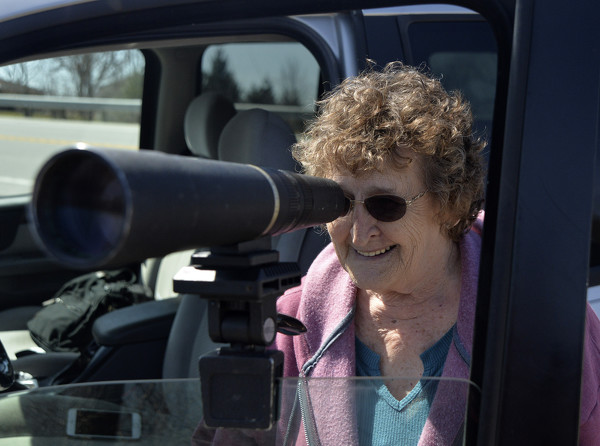Saturday, April 6th, 2019
Grand Lake bald eagle population still thriving
By Leslie Gartrell

Photo by Dan Melograna/The Daily Standard
An eagle gazes out from its nest in a tree near U.S. 127 south of Celina on Wednesday.
CELINA - Bald eagles in the area continue to thrive with at least 11 nests in Mercer and Auglaize counties.
The number of nests have steadily increased over the years, said Mark Schemmel, State Wildlife Officer of Auglaize County. Jill Bowers, a Mercer County resident and eagle enthusiast, said she is aware of three to four nests within the county.
The longtime bird watcher said she knows of a nest in the Mercer Wildlife Area, one near the Prairie Creek treatment train and another along State Route 29 near Celina Lynx Golf Course.
Those numbers reflect their continued recovery from a low of four breeding pairs in Ohio in 1979. In 2018, the number of estimated breeding pairs had increased to 286, and pairs produced an estimated 445 young, according to the Ohio Department of Natural Resource's Division of Wildlife.
Habitat destruction and degradation, illegal shooting and contaminated food sources, largely as a consequence of DDT, decimated the eagle population by the 1970s, according to the U.S. Fish and Wildlife Service.
Eagle eggs were affected by increased pesticide use during the 1950s and 1960s, according to Ohio History Central. The eggs did not hatch because they were either infertile or their shells were so thin the weight of the adult would crush them. No young birds were surviving to replace the dying adults.
Bald eagles were officially declared an endangered species in 1967 throughout the United States. They then were listed as endangered throughout the continental U.S. in 1978 by the U.S. Fish and Wildlife Service.
When state officials started a volunteer eagle monitoring program in 1995, Bowers quickly joined. And while she stopped volunteering in 2008, Bowers still loves to stay involved and monitor the birds on her own.
"I'm a part of that baby's life," she said.
Now, thanks to conservation efforts, the eagle population has soared and in 2017 was removed from the federal list of threatened and endangered species. The national symbol was removed from Ohio's endangered listing in 2012.
Female eagles in Ohio usually lay one to three eggs from mid-February through March, according to the ODNR division of wildlife. The eggs are incubated by both parents for approximately 35 days. The birds learn to stretch, flap their wings and practice flight by limb-hopping in the trees, Bowers said. The eaglets leave the nest after three months, normally before July 4.
A breeding pair of eagles nesting near the Mercer Wildlife Area are close to the property of Mike Brackman. Brackman said he'd never really paid much attention to the birds, but enough people stop by his property during nesting season for him to take notice. Mark Klosterman made the trip from Greenville last year to visit the birds on Brackman's property and made the trip again this year to take photos.
The bird of prey's ideal place to call home is close to open waterways where they can stretch their 71/2-foot wingspan and feast on fish. They also, however, look for sites that are somewhat secluded. This is particularly important when the nest is being established and young raised, according to the ODNR Division of Wildlife. They are highly territorial, and too much interference from other eagles can result in problems at the nest site.
The division participates in an annual mid-winter survey of bald eagles, which this year found a record-setting number of 230 immature eagles and 210 adults. The division said this is a 75% increase over last year's total of 252 eagles. A 30% increase in breeding pairs also was noted in 2018, which the division said is unusually high compared to the five-year average increase of 9%.
"I am proud of our agency's restoration efforts to bring back this iconic symbol of our nation, and thrilled the population is thriving here," said Kendra Wecker, chief of the ODNR Division of Wildlife, in a news release. "Each time an eagle soars overhead, Ohioans have the opportunity to experience the natural beauty in our state. Nesting season is an exciting time, and I hope we can exceed 300 nests this year."

Photo by Dan Melograna/The Daily Standard
Jill Bowers looks through her telescope to view bald eagles in their nest.


